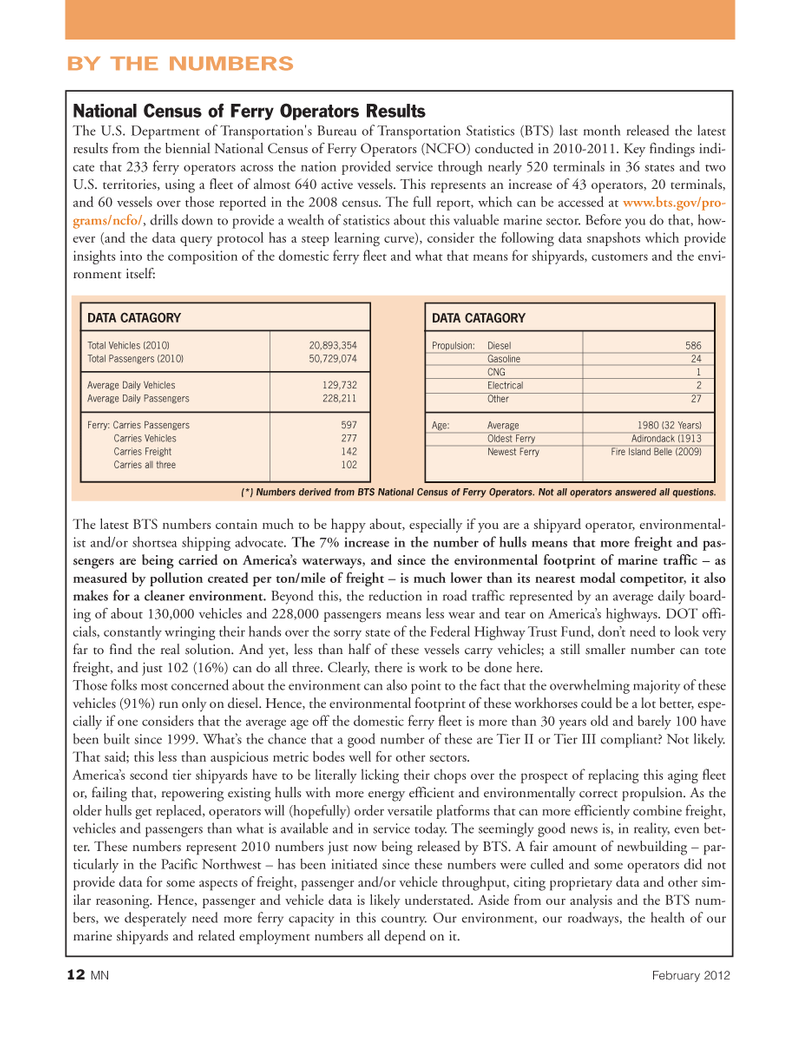
Page 12: of Marine News Magazine (February 2012)
Inland Bulk Transportation
Read this page in Pdf, Flash or Html5 edition of February 2012 Marine News Magazine
BY THE NUMBERS National Census of Ferry Operators ResultsThe U.S. Department of Transportation's Bureau of Transportation Statistics (BTS) last month released the latest results from the biennial National Census of Ferry Operators (NCFO) conducted in 2010-2011. Key findings indi- cate that 233 ferry operators across the nation provided service through nearly 520 terminals in 36 states and two U.S. territories, using a fleet of almost 640 active vessels. This represents an increase of 43 operators, 20 terminals, and 60 vessels over those reported in the 2008 census. The full report, which can be accessed at www.bts.gov/pro- grams/ncfo/, drills down to provide a wealth of statistics about this valuable marine sector. Before you do that, how- ever (and the data query protocol has a steep learning curve), consider the following data snapshots which provide insights into the composition of the domestic ferry fleet and what that means for shipyards, customers and the envi- ronment itself: The latest BTS numbers contain much to be happy about, especially if you are a shipyard operator, environmental- ist and/or shortsea shipping advocate. The 7% increase in the number of hulls means that more freight and pas- sengers are being carried on America?s waterways, and since the environmental footprint of marine traffic ? as measured by pollution created per ton/mile of freight ? is much lower than its nearest modal competitor, it also makes for a cleaner environment. Beyond this, the reduction in road traffic represented by an average daily board- ing of about 130,000 vehicles and 228,000 passengers means less wear and tear on America?s highways. DOT offi- cials, constantly wringing their hands over the sorry state of the Federal Highway Trust Fund, don?t need to look very far to find the real solution. And yet, less than half of these vessels carry vehicles; a still smaller number can tote freight, and just 102 (16%) can do all three. Clearly, there is work to be done here. Those folks most concerned about the environment can also point to the fact that the overwhelming majority of these vehicles (91%) run only on diesel. Hence, the environmental footprint of these workhorses could be a lot better, espe- cially if one considers that the average age off the domestic ferry fleet is more than 30 years old and barely 100 have been built since 1999. What?s the chance that a good number of these are Tier II or Tier III compliant? Not likely. That said; this less than auspicious metric bodes well for other sectors. America?s second tier shipyards have to be literally licking their chops over the prospect of replacing this aging fleet or, failing that, repowering existing hulls with more energy efficient and environmentally correct propulsion. As the older hulls get replaced, operators will (hopefully) order versatile platforms that can more efficiently combine freight, vehicles and passengers than what is available and in service today. The seemingly good news is, in reality, even bet- ter. These numbers represent 2010 numbers just now being released by BTS. A fair amount of newbuilding ? par- ticularly in the Pacific Northwest ? has been initiated since these numbers were culled and some operators did not provide data for some aspects of freight, passenger and/or vehicle throughput, citing proprietary data and other sim- ilar reasoning. Hence, passenger and vehicle data is likely understated. Aside from our analysis and the BTS num- bers, we desperately need more ferry capacity in this country. Our environment, our roadways, the health of our marine shipyards and related employment numbers all depend on it. DATA CATAGORY Propulsion:Diesel 586Gasoline24CNG1Electrical2Other27Age: Average 1980 (32 Years) Oldest FerryAdirondack (1913 Newest FerryFire Island Belle (2009) DATA CATAGORY Total Vehicles (2010) 20,893,354Total Passengers (2010) 50,729,074Average Daily Vehicles 129,732Average Daily Passengers228,211Ferry: Carries Passengers597Carries Vehicles 277Carries Freight 142Carries all three 102(*) Numbers derived from BTS National Census of Ferry Operators. Not all operators answered all questions. 12MNFebruary 2012 MN#2 (1-17):MN 2011 Layouts 2/3/2012 11:26 AM Page 12

 11
11

 13
13
